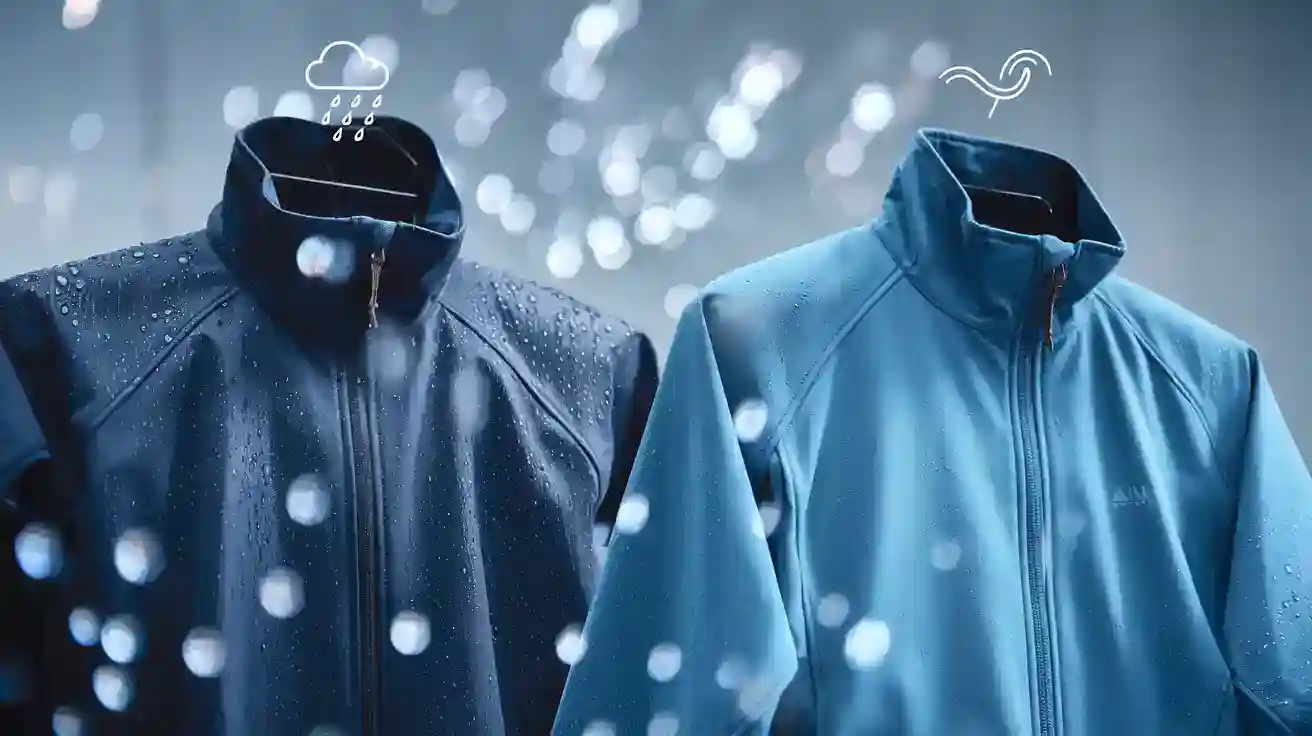What Sets Hardshell Jackets Apart from Softshell Jackets

When you select a jacket for outdoor activities, the main difference you need to consider is waterproofness and breathability. Over 40% of outdoor enthusiasts like you put a high priority on jackets that offer both, showing how much these features matter. Choosing the right jacket can make a huge difference in your comfort and performance. If you want the best hardshell jacket for wet or harsh weather, focus on waterproof protection.
The right choice helps you stay dry, comfortable, and ready for any adventure.
Principales conclusiones
- Chaquetas rígidas offer full waterproof and windproof protection, making them ideal for harsh weather and heavy rain or snow.
- Softshell jackets provide high breathability, flexibility, and comfort, perfect for active outdoor activities in mild or light rain conditions.
- Choose a hardshell jacket for demanding adventures like mountaineering or skiing where weather protection is critical.
- Pick a softshell jacket for activities like hiking, running, or climbing that need freedom of movement and sweat management.
- Consider your activity, weather, and comfort needs to select the right jacket and stay dry, comfortable, and ready for any adventure.
Chaqueta rígida

Características
You get the best hardshell jacket when you choose one made with advanced multi-layer membrane technology. Most hardshell jackets use a three-layer construction. The outer layer is tough nylon with a Revestimiento hidrófugo duradero (DWR). This keeps water from soaking in and helps maintain breathability. The middle layer is a waterproof membrane, like Gore-Tex Pro or eVent, which blocks rain and wind but lets sweat escape. The inner lining adds comfort and protects the membrane. Many hard shell jackets include waterproof zippers and taped seams for fully waterproof performance. Some brands add pit zips and stretchy panels to improve breathability and mobility. You will notice that the best hardshell jackets feel stiffer than soft shells, but this stiffness means more protection.
Ventajas
You can count on a hardshell jacket for maximum protection in harsh weather. These jackets are fully waterproof and windproof, so you stay dry even in heavy rain or snow. The advanced multi-layer membrane technology gives you high-performance outer gear that stands up to extreme conditions. Durability is a key advantage. Hardshell jackets resist abrasions and last for years, even with regular use in rough terrain. You get reliable weather protection and long-lasting performance. Many hard shell jackets also pack down small, so you can carry them easily in your backpack. If you want the best hardshell jacket for ski outerwear or mountaineering, look for models with helmet-compatible hoods and ventilation zips.
Tip: Proper care, like gentle washing and reapplying DWR, helps your hardshell jacket keep its waterproofness and durability for many seasons.
Best Uses
You should wear a hard shell jacket when you need fully waterproof and windproof protection. Outdoor experts recommend hardshell jackets for activities like mountaineering, skiing, climbing, snowboarding, and high-altitude hiking. These jackets give you maximum protection against rain, snow, and strong winds. They are the best hardshell jackets for demanding adventures where weather protection is critical. Hard shell jackets work well as high-performance outer layers for snowmobiling and other cold, wet weather sports. If you want to stay dry and safe in extreme conditions, a hardshell jacket is your best choice.

Chaqueta Softshell

Características
You will notice that a softshell jacket stands out for its breathability, flexibility, and comfort. The fabric in softshell jackets stretches in all directions, giving you a wide range of motion for activities like climbing or cycling. Most softshell jackets use a durable, abrasion-resistant outer layer that handles rough use. The inside often feels soft and warm, sometimes lined with fleece for extra comfort. A soft shell jacket usually has a Durable Water Repellent (DWR) coating, so it resists light rain and wind. However, a soft shell jacket is not fully waterproof. You can see the main differences between softshell jackets and hardshell jackets in the table below:
| Característica | Chaquetas Softshell | Chaquetas rígidas |
|---|---|---|
| Estanqueidad | Weather resistant with DWR; not fully waterproof; suitable for light rain and wind | Fully waterproof with sealed seams; designed for heavy rain and snow protection |
| Transpirabilidad | High breathability; allows sweat vapor to escape; suitable for high-output activities | Less breathable; can become clammy during intense activity |
| Stretch/Flexibility | Stretch-woven fabrics offering good mobility and comfort | Less stretchy; more rigid, limiting range of motion |
| Resistencia a la abrasión | Durable, abrasion-resistant fabrics suitable for climbing and rugged use | Generally less abrasion resistant |
| Peso | Heavier due to abrasion-resistant fabrics | Lighter but less flexible |
| Uso previsto | Mild, windy, or lightly wet conditions; layering piece; high-output activities | Severe, wet weather; full waterproof protection needed |
Ventajas
You get several benefits when you choose a chaqueta softshell. The main advantage is comfort. Softshell jackets use elastic materials and flexible construction, so you move freely during any activity. The soft inner lining keeps you warm and cozy, even on long days outside. A soft shell jacket also offers better breathability than a hardshell, letting sweat escape and keeping you dry during high-energy sports. You will find that softshell jackets resist wind and light rain, making them more protective than a fleece but less bulky than a hardshell. Many users like the adjustability features, such as elastic cuffs and drawcords, which help you get a snug fit. The best softshell jackets combine stretch, warmth, and weather resistance for top performance in mild conditions.
Tip: If you want a jacket for active days with changing weather, a soft shell jacket gives you the right balance of protection and comfort.
Best Uses
You should pick a softshell jacket for outdoor activities that need flexibility and breathability. Softshell jackets work best for senderismo, running, cycling, camping, and climbing. Many people also use soft shell jackets for fishing, hunting, and even military or law enforcement work. When you expect mild weather, cool temperatures, or only light rain, a soft shell jacket is your go-to choice. The best softshell jackets keep you comfortable during high-output activities, where you need to move freely and stay dry from sweat. If you want a jacket that performs well in dry or slightly wet conditions, a soft shell jacket delivers reliable performance and comfort.
- Senderismo
- Ejecutar
- Ciclismo
- Camping
- Escalada
- Fishing
- Hunting
- Military and law enforcement
Hard Shell vs. Soft Shell
Protección contra la intemperie
When you face unpredictable or severe weather, you need reliable weather protection. Hard shell jackets deliver the highest level of waterproof performance. These jackets use advanced membranes like Gore-Tex or eVent, along with taped seams and durable outer fabrics. You can count on a hard shell to keep you dry in heavy rain or snow. Most hard shell jackets are fully waterproof, making them the best choice for all-day protection in harsh conditions.
Softshell jackets, on the other hand, focus on water resistance rather than full waterproofing. A softshell jacket uses a DWR (Durable Water Repellent) coating to shed light rain and snow. However, it will eventually soak through during prolonged exposure to wet weather. If you expect only mild precipitation or want a jacket for dry, windy days, a soft shell jacket offers enough weather protection without the stiffness of a hard shell.
| Característica | Chaquetas rígidas | Chaquetas Softshell |
|---|---|---|
| Estanqueidad | Fully waterproof with membranes, taped seams, and durable fabrics; ideal for heavy rain or snow | Water-resistant with DWR; protects against light rain or snow but not fully waterproof |
| Protección contra la intemperie | Maximum, even in extreme conditions | Moderate, best for mild or changing weather |
Tip: Choose the best hardshell jacket if you need fully waterproof protection for long days in the mountains or during storms.
Transpirabilidad
Breathability matters when you stay active outdoors. Hardshell jackets use waterproof membranes that allow some moisture vapor to escape, but these membranes also limit airflow. You may notice that a hardshell can feel clammy during high-output activities, especially if you sweat a lot. Some of the best hardshell jacket designs include pit zips or ventilation panels to help with airflow, but breathability still falls behind that of softshell jackets.
Softshell jackets excel in breathability. The fabric in a softshell jacket allows heat and sweat to escape quickly, keeping you dry and comfortable during aerobic activities. You will find that softshell jackets are ideal for hiking, running, or climbing, where you need to move fast and stay cool. The difference in breathability becomes clear when you compare the two in intense activity—softshell jackets keep you drier and more comfortable.
| MVTR Range (g/m²/24h) | Breathability Rating | Typical Jacket Type |
|---|---|---|
| < 5,000 | Very poor (sweaty) | N/A |
| 5,000–10,000 | Suitable for urban commuting | 2-layer softshell jackets |
| 10,000–15,000 | Good for moderate activity | 2.5-layer hardshell jackets |
| ≥ 20,000 | Ideal for intense activity | 3-layer hardshell jackets with ventilation |
Note: For high-output activities, a softshell jacket offers the best balance of breathability and comfort.
Comfort and Flexibility
You will notice a big difference in comfort and flexibility between hardshell and softshell jackets. Hard shell jackets use rigid, crinkly fabrics that protect you from the elements but limit your range of motion. The fit can feel restrictive, especially if you need to stretch or reach during activities like climbing. Some hard shell jackets add stretch panels, but overall, they remain less flexible than softshells.
Softshell jackets stand out for their comfort. The fabric feels soft, stretchy, and warm against your skin. Many soft shell jackets include fleece linings that wick sweat and add extra coziness. You can move freely in a softshell jacket, making it perfect for activities that demand flexibility. Consumer surveys show that users rate softshell jackets higher for comfort, especially during long days outside or when layering over other clothes.
If comfort and freedom of movement are your top priorities, a soft shell jacket will serve you better than a hard shell.
Durability and Weight
Durability and weight play a big role in your jacket choice. Hard shell jackets use tough outer fabrics that resist abrasions and last for years, even with regular use in rough terrain. You get a lightweight and highly packable design with many hard shell jackets, which makes them easy to stash in your backpack for emergencies. Some ultralight models can pack down to the size of a water bottle.
Softshell jackets are usually heavier and bulkier than hardshells. The thicker, stretch-woven fabrics add weight but also improve comfort and warmth. While softshell jackets handle abrasion well, they do not match the long-term durability of the best hardshell jacket in extreme environments. If you need a jacket that packs small and stands up to years of hard use, a hard shell jacket is the better choice.
| Característica | Chaquetas rígidas | Chaquetas Softshell |
|---|---|---|
| Average Weight | Generally lighter | Thicker and heavier |
| Empaquetabilidad | Highly packable, can be compacted easily | Bulkier, occupy more space in travel gear |
| Durabilidad | Excellent, especially in rough terrain | Good, but not as long-lasting in harsh use |
For the best combination of durability, weight, and packability, choose a hard shell jacket for your most demanding adventures.
Summary Table: Soft Shell vs. Hard Shell Jackets
| Aspecto | Hard Shell Jackets | Soft Shell Jackets |
|---|---|---|
| Protección contra la intemperie | Fully waterproof, maximum protection | Water-resistant, moderate protection |
| Transpirabilidad | Lower, can trap heat and moisture | High, ideal for aerobic activities |
| Comfort & Mobility | Rigid, less flexible, less comfortable | Soft, stretchy, very comfortable |
| Peso y capacidad de embalaje | Lighter, highly packable | Heavier, bulkier |
| Durabilidad | Excellent in harsh conditions | Good, but less in extreme environments |
| Mejor uso | Harsh weather, heavy rain or snow, emergencies | Mild weather, high-mobility, active pursuits |
When you compare soft shell vs. hard shell jackets, think about your activity, expected weather, and comfort needs. Hardshell and softshell jackets each have strengths. The best hardshell jacket gives you fully waterproof protection and durability for extreme conditions. A softshell jacket offers breathability, comfort, and flexibility for active days in milder weather.
Elegir la chaqueta adecuada
Selecting the best outer layer for your adventure means thinking about your activity, the weather, and your comfort needs. You want a jacket that matches your pace, the climate, and how you like to move. Let’s break down the main factors so you can make a confident choice.
Tipo de actividad
Your activity shapes what jacket works best. High-intensity sports like trail running, ski touring, or mountaineering demand jackets that manage sweat and allow freedom of movement. For these, softshell jackets often stand out. They offer breathability, flexibility, and enough weather resistance for most days on the mountain. If you plan to climb, cycle, or hike fast, a softshell gives you the comfort and stretch you need.
For harsh environments or slower-paced activities where you might face heavy rain or snow, hardshell jackets provide the protection you need. They keep you dry and shielded from strong winds. If you spend long hours in wet or cold conditions, such as alpine climbing or using ski outerwear, a hardshell jacket is the high-performance outer you want.
Here’s a quick comparison to help you match jacket type to your activity:
| Tipo de actividad | Recommended Jacket | Performance Considerations |
|---|---|---|
| Trail Running | Softshell | High breathability, flexibility, light water resistance |
| Mountaineering | Hardshell | Waterproof, windproof, durable, helmet-compatible hoods |
| Ski Touring | Softshell/Hardshell | Softshell for most days; hardshell for storms or deep snow |
| Escalada | Softshell | Stretchy, abrasion-resistant, breathable |
| Backpacking/Hiking | Hardshell | Lightweight, packable, reliable in changing weather |
| Urban/Everyday Use | Softshell | Comfort, style, moderate weather protection |
Tip: For high-intensity activities, prioritize breathability and fit. For extreme weather, choose maximum protection.
Condiciones meteorológicas
Weather plays a huge role in your jacket decision. Hardshell jackets excel in wet, windy, and unpredictable conditions. Their waterproof membranes and sealed seams keep you dry during heavy rain or snow. If you expect storms, strong winds, or rapid weather changes, a hardshell is your safest bet.
Softshell jackets shine in mild, dry, or slightly wet weather. They resist light rain and block wind, but they do not keep you dry in a downpour. Softshells work well for cool, breezy days or when you want to stay comfortable during aerobic activities. If you plan to layer, softshells add warmth and flexibility without overheating.
- Hardshell: Best for heavy rain, snow, strong winds, and rapidly changing mountain weather.
- Softshell: Ideal for mild temperatures, light rain, moderate wind, and dry climates.
Nota: Hybrid jackets combine features of both but may compromise on full waterproofing or flexibility.
Comfort Needs
Comfort can make or break your outdoor experience. You want a jacket that feels good, moves with you, and adapts to your needs. Softshell jackets often win for comfort. They use soft linings, stretchy fabrics, and ergonomic designs that let you move freely. Features like adjustable cuffs, hoods, and well-placed pockets add to your comfort.
Hardshell jackets focus on protection, but many now include comfort features like articulated sleeves, pit zips for ventilation, and adjustable hems. Look for a fit that allows layering without feeling bulky. Lightweight and packable designs help you carry your jacket easily.
Key comfort features to look for:
- Soft linings and breathable fabrics
- Adjustable cuffs, hems, and hoods
- Well-placed, zippered pockets
- Lightweight insulation for warmth without bulk
- Ergonomic design for natural movement
Pro Tip: Try on different jackets with your usual layers to check fit and mobility. Look for features that match your activity and climate.
By considering your activity, the weather, and your comfort needs, you can choose the right jacket for any adventure. The right balance of protection, breathability, and comfort ensures you stay focused on your goals, not your gear.
You can see the main differences between hardshell and softshell jackets in the table below:
| Característica | Chaquetas rígidas | Chaquetas Softshell |
|---|---|---|
| Protección contra la intemperie | Máximo | Moderado |
| Transpirabilidad | Moderado | Alta |
| Flexibilidad | Bajo | Alta |
| Confort | Decent | Excelente |
- Hardshell jackets keep you dry in harsh weather but may feel hot during active use.
- Softshell jackets offer comfort and breathability, but you may need extra protection in heavy rain.
- Many outdoor experts suggest carrying both types for the best balance.
Tip: Match your jacket to your activity and weather. You will stay comfortable and protected on every adventure.
PREGUNTAS FRECUENTES
What is the main difference between a hardshell and a softshell jacket?
You get full waterproof protection with a hardshell jacket. A chaqueta softshell gives you more breathability and comfort. Choose a hardshell for heavy rain or snow. Pick a softshell for active days in mild weather.
Can you wear a softshell jacket in the rain?
A softshell jacket resists light rain because of its DWR coating. It will not keep you dry in heavy or long-lasting rain. For wet conditions, you should use a hardshell jacket.
How do you clean and care for your hardshell jacket?
Wash your hardshell jacket with a gentle detergent. Avoid fabric softeners. Reapply DWR treatment after several washes. Always follow the care label. Proper care keeps your jacket waterproof and durable.
Should you size up when buying a hardshell jacket?
You may want to size up if you plan to layer clothing underneath. Try on the jacket with your usual layers. Make sure you can move your arms freely and zip it up without feeling tight.
Can you use a hardshell jacket for everyday wear?
You can wear a hardshell jacket daily, especially in rainy or windy weather. Some people find them less comfortable than softshells for casual use. For daily comfort, consider a softshell jacket unless you need full waterproof protection.

